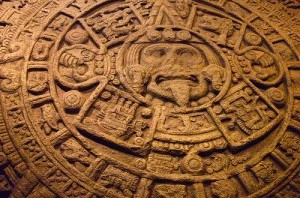It’s time to demystify the Mayan calendar, which ends on December 21, 2012. It is causing quite a stir among many people who are wondering if the Mayans have really identified this date as the time for worldwide catastrophic events.
My husband and I were traveling through a small town recently and stopped at a local café to eat. A young man seated near us was passionately trying to persuade his friends to stock up on food, water, batteries, and other supplies, because December 21, 2012, was going to start a period of worldwide catastrophes.
Later that week, I read a news account of a large number of New Agers who were gathering in France near a mountain where they believe space ships were coming on December 21 to beam them up before calamity struck the earth.
During the following week, I asked several people what they thought about December 21. Some people said they planned to buy extra food and supplies for that time–just in case.
So, what are Christians to make of an ancient Mayan Indian prediction? First of all, the early Mayans were not a primitive ignorant tribe.
They had an in-depth scientific knowledge of astronomy, made correct observations of heavenly bodies, and developed accurate calendars based on these skills. Amazingly, they were able to recognize that our sun travels in a long pathway through the skies, and it was predicted to intersect another astrological pathway in the skies on the winter solstice (December 21) in 2012. They considered this intersection to be so unusual that they may have started with this date and worked their way backwards as they constructed their calendar. The Mayans also developed shorter accurate calendars, but the long count calendar is the one getting all the attention this year.
The end of some of the Mayan calendars was believed to mark when the sun moved into a new house. There is evidence that entire Mayan cities moved into new homes on these dates, abandoning or burning their old homes as they left.
The Mayans didn’t progressively acquire their knowledge of astronomy on their own. It seems as if older civilizations across the Atlantic Ocean, such as Egyptians, Phoenicians, and Chaldeans, were the first to possess accurate science-based knowledge of astronomy and keep up with time and dates. Some of these early civilizations also produced skilled sailors who were able to travel far and wide in well-built ships looking for minerals and other resources.
At some point, a group of Mediterranean navigators are almost certain to have crossed the Atlantic and established cities in the Central America area, from which the Mayans descended. Similarities between the Mayans and the early Mediterranean civilizations are strong evidence of this connection–massive pyramids, a cuneiform type of written language, a similar mathematical system, similarities in artistic works, and accurate knowledge of astronomy.
The Mayans probably lost much of their scientific and technological knowledge over the centuries as they became immersed in pagan worship of the sun and eventually lost contact with Europeans, but they retained the knowledge used to make their calendars.
As for the last day of the old Mayan calendar, it is just another day in which the sun may cross an astrological pathway in the sky on December 21, 2012. It may well be a rare solar event, but it’s no more a sign of bad luck than someone walking under a ladder on Friday 13th at the same time a black cat ran across the person’s pathway. Christians would do well to reject such superstitious signs as a source of knowledge and reality.

Thanks for posting on Creation Conversations.